

Crowdsourcing, for the Birds. Dean Rutz/Associated Press Migrating Vaux Swifts flocking around a chimney.

Stationary sensors can measure things like carbon dioxide levels and highway traffic, but it takes people to note the type and number of birds in an area. Mr. National Geographic Live! “Reviving the Heart of Wild Africa” Africa is changing rapidly.
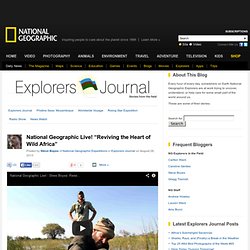
Roads and railways are being built into remote wilderness areas to enable economic development through resource use. Gold, oil, timber, rare earth minerals, iron, coal, gas and much else has been extracted at an alarming rate over the last 50 years. The wildlife trade has surged to new heights on a continent with dwindling animal numbers. WWF Sacred Earth program: Religious leaders should preach for the environment. Photo by Kim Jae-Hwan/AFP/Getty Images Can spiritual leaders guide their flocks to be stewards of the Earth?

Dekila Chungyalpa is founder and director of the Sacred Earth program for WWF, the international conservation organization. She says religious values are often consistent with conservation efforts, and it’s time for religious leaders to start preaching for the environment. Curtis Abraham: What is the Sacred Earth program? Dekila Chungyalpa: We are trying to provide faith leaders and religious institutions with a platform on which they can build conservation messages and lead environmental change.
CA: Where do religion and conservation intersect? CA: So how can religious leaders make a difference? I think there are two levels on which they can help environmental efforts. The Global Religious Landscape. Worldwide, more than eight-in-ten people identify with a religious group.
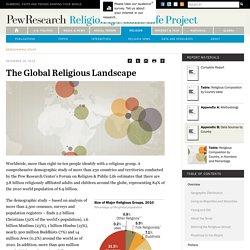
A comprehensive demographic study of more than 230 countries and territories conducted by the Pew Research Center’s Forum on Religion & Public Life estimates that there are 5.8 billion religiously affiliated adults and children around the globe, representing 84% of the 2010 world population of 6.9 billion. The demographic study – based on analysis of more than 2,500 censuses, surveys and population registers – finds 2.2 billion Christians (32% of the world’s population), 1.6 billion Muslims (23%), 1 billion Hindus (15%), nearly 500 million Buddhists (7%) and 14 million Jews (0.2%) around the world as of 2010.
In addition, more than 400 million people (6%) practice various folk or traditional religions, including African traditional religions, Chinese folk religions, Native American religions and Australian aboriginal religions. India bans captive dolphin shows, says dolphins should be seen as ‘non-human persons’ Desert 'carbon farming' to curb CO2. 1 August 2013Last updated at 10:45 ET By Matt McGrath Environment correspondent, BBC News Jatropha seeds can be used to produce biofuel but the plant itself can absorb large amounts of CO2 Scientists say that planting large numbers of jatropha trees in desert areas could be an effective way of curbing emissions of CO2.
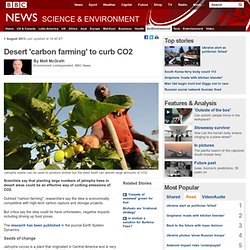
Dubbed "carbon farming", researchers say the idea is economically competitive with high-tech carbon capture and storage projects. But critics say the idea could be have unforeseen, negative impacts including driving up food prices. The research has been published in the journal Earth System Dynamics. www.earth-syst-dynam.net/4/237/2013/esd-4-237-2013.pdf. Snow leopards and wild yaks becoming 'fashion victims' Snow leopards, wild yaks and other iconic wildlife on the world's highest mountains and great steppes are becoming "fashion victims" of the surging global trade in cashmere, new research has revealed.

Scientists found wildlife being driven to the margins of survival by the "striking but unintended consequences" of huge increases in the numbers of the goats producing the luxurious lightweight wool. The herds eat up the grass that previously supported antelopes, wild asses and their predators. Further problems were retaliatory killings of leopards and wolves by herders after livestock attacks, the killing of wild animals by herders' dogs and the transfer of disease from livestock to wild animals. "In the absence of commitment across global and local scales, this iconic wildlife will cease to persist as they have for millennia, concluded an international team of researchers in the journal Conservation Biology. Globalization of the Cashmere Market and the Decline of Large Mammals in Central Asia - BERGER - 2013 - Conservation Biology. Climate Change 10,000 Times Faster Than Evolution.
Evolution can be fast, but not fast enough to keep up with the rate of human-caused climate change, say two researchers who have studied the evolution rates of hundreds of species in the past.
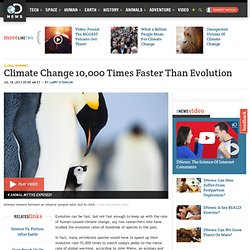
In fact, many vertebrate species would have to speed up their evolution rate 10,000 times to match today's pedal-to-the-metal rate of global warming, according to John Wiens, an ecology and evolutionary biology professor at the University of Arizona, and Ignacio Quintero, a postgraduate research assistant at Yale University. "A big question is 'Can some species adapt quickly enough to survive? '" said Wiens. “So we looked at 17 groups of animals” comprising 540 species that included amphibians, birds, reptile and mammals, to see how they adapted to temperature changes in the past. “We estimated the rate of climate change for these species.”
How Global Warming Will Change Your Life 10 Signs Climate Change Is Already Happening. Saving species by translocation – new IUCN Guidelines. 12 August 2013 | News story.
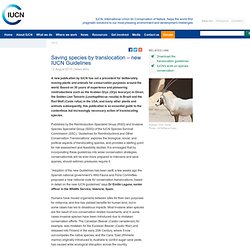
Many Species Will Have To Evolve 10,000 Times Faster To Adapt To Climate Change, Study Finds. By Katie Valentine "Many Species Will Have To Evolve 10,000 Times Faster To Adapt To Climate Change, Study Finds"

To Fight Warming, Brits Plan to Launch a Huge Balloon and Really Long Pipe. When most people think of simulating a volcano, they think of baking soda, vinegar, and third grade science fair projects.

A team of British researchers are thinking more along the lines of a giant balloon the size of a soccer stadium and a 12-mile garden hose that can pipe chemicals into the stratosphere to slow global warming. Does habitat replacement let developers off the hook? - environment - 24 June 2013. Read full article Continue reading page |1|2 Eco-offsetting – creating habitats to replace ones lost to development – can save wildlife, but may instead help business trump nature AT THE far eastern end of the Thames estuary, amid a scruffy sprawl of London satellite towns, is a spot known as Lodge Hill.
It is a military junkyard, littered with abandoned munitions stores, sentry boxes and an anti-aircraft gun emplacement from the first world war. Trainees from the Royal School of Military Engineers once practised driving bulldozers here.